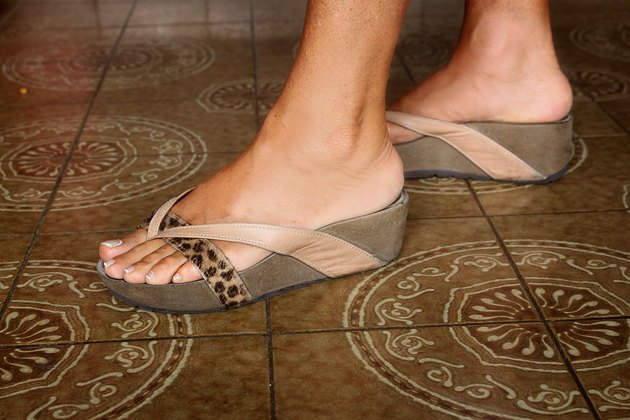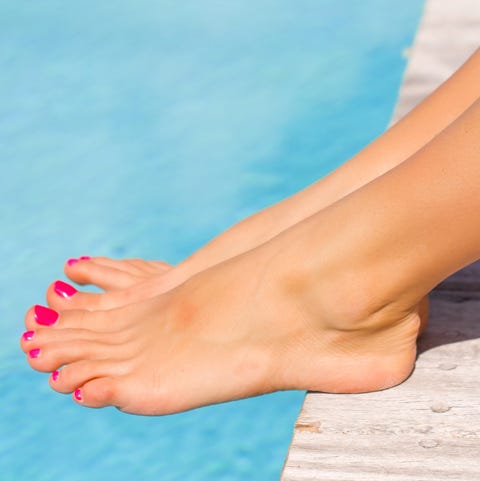Our joints can crack either by force of manipulation or normal movement. Some people’s joints crack when they walk up or down stairs, other people experience involuntary popping or cracking when they move their arms or stretch their back. Still other people manipulate the knuckles of their fingers to crack them willfully. Either way, there are a couple of explanations for what is happening when the body’s joints crack.
- My Daughter's Ankles Crack When She Walks
- My Ankles Pop
- My Ankles Keep Cracking
- My Ankles Crack When I Run
- Why Does My Ankle Pop
The joints of the body that often make a cracking or popping sound include the knuckles, the back and neck, the knees, ankles, and elbows. Sometimes the joints crack audibly and other times you may feel it without hearing a sound. What is happening when your joints crack could be the escaping of gases or simply the movement of tendons and ligaments within the joint.
A healthy joint is comprised of bone surrounded by smooth cartilage, which is protected by a capsule lined with synovial membranes that produces fluid. This fluid contains oxygen, nitrogen and carbon dioxide gasses. When joints crack, it could be the result of the joint capsule being rapidly stretched, which causes the formation and release of gas bubbles. The release of gas can cause the popping sound you feel and sometimes hear.
The ankles and legs are common sites of swelling because of gravity’s effect on the fluids in the human body. However, fluid retention from gravity isn’t the only cause of a swollen ankle or leg. Injuries and subsequent inflammation can also cause fluid retention and swelling.
A swollen ankle or leg can cause the lower part of the leg to appear larger than normal. The swelling can make it difficult to walk. It may be painful, with the skin over your leg feeling tight and stretched out. While the condition isn’t always a reason for concern, knowing its cause can help rule out a more serious problem.
Clicking or crunching in the ankles or feet can be caused by a number of things. Most people fear that the clicking is caused by bone hitting bone. However, thankfully nowadays this is rare. If you have this, it is likely that for many years you have been suffering severe pain and weight bearing has. But it has to be rapid; the same movement done more slowly won't produce a crack. 'For example, my ankle sometimes cracks when I run,' Dr Vagg said. 'It doesn't crack when I walk. The peroneal tendons wrap around the fibula or the little bone on the outside of the ankle. If these tendons are not held tightly against the bone they may snap or pop. Popping or snapping of these tendons can occur without injury if your ligaments are a little loose. True peroneal tendon instability often occurs after a severe ankle sprain. Because the ligaments that keep the tendons in the groove have weakened due to sprains, it allows the tendons to come out and snap against the ankle bone. While popping your ankles is usually painless, it can cause the tendon to tear if the ankle is rotated past its threshold, which will result in swelling and pain when walking. The peroneal tendons wrap around the fibula or the little bone on the outside of the ankle. If these tendons are not held tightly against the bone they may snap or pop. Popping or snapping of these tendons can occur without injury if your ligaments are a little loose. True peroneal tendon instability often occurs after a severe ankle sprain.
If you stand a large part of the day, you may develop a swollen ankle or leg. Older age can also make swelling more likely. A long flight or car ride may cause a swollen angle, leg, or foot too.
Certain medical conditions can also result in a swollen ankle or leg. These include:
- being overweight
- venous insufficiency, in which problems with valves of the veins prevents blood from flowing back to the heart
- pregnancy
- blood clots in the leg
- leg infection
- lymphedema, or swelling caused by a blockage in the lymphatic system
- previous surgery, such as pelvic, hip, knee, ankle, or foot surgery
Taking certain medications can lead to this symptom. These include:
- antidepressants, including phenelzine (Nardil), nortriptyline (Pamelor), and amitriptyline
- calcium channel blockers used to treat high blood pressure, including nifedipine (Adalat CC, Afeditab CR, Procardia), amlodipine (Norvasc), and verapamil (Verelan)
- hormone medications, such as birth control pills, estrogen, or testosterone
- steroids
Swelling in the ankle and leg could be the result of inflammation due to acute or chronic injury. Conditions that can cause this type of inflammation include:
- broken leg
- Achilles tendon rupture
Edema
Edema is a type of swelling that may occur when extra fluid flows into these areas of your body:
- legs
- arms
- hands
- ankles
- feet
Mild edema can be caused by pregnancy, premenstrual symptoms, consuming too much salt, or being in one position for a long time. This type of leg or ankle swelling can be a side effect of certain medications, such as:

- thiazolidinediones (used to treat diabetes)
- steroids
- anti-inflammatory medications
- estrogen
Edema can be a symptom of a more serious medical issue, such as:
- kidney disease or damage
- veins that are weak or damaged
- a lymphatic system that isn’t working properly
Mild edema will usually go away without any medical treatment. However, if you have a more serious case of edema, it can be treated with medications.
Swollen ankles and legs are common when you’re pregnant because of factors such as:
- natural fluid retention
- pressure on veins due to the extra weight of your uterus
- changing hormones
The swelling tends to go away after you deliver your baby. Until then, try these tips to prevent or lessen the swelling.
Swelling prevention in pregnancy
- Avoid standing for long periods of time.
- Sit with your feet raised.
- Keep as cool as possible.
- Spend time in the pool.
- Keep a regular exercise routine as approved by your doctor.
- Sleep on your left side.
Don’t reduce your water intake if you have swelling. You need plenty of fluids during pregnancy, usually at least 10 cups per day.
If the swelling is painful, you should see your doctor to make sure that your blood pressure is normal. Your doctor will also want to check if you have a blood clot and rule out other possible conditions, such as preeclampsia.
Seek emergency medical care if you also have heart-related symptoms. These can include:
- trouble breathing
- mental confusion
You should also seek emergency treatment if you notice an abnormality or crookedness to the ankle that wasn’t there before. If an injury prevents you from putting weight on your leg, this is also cause for concern.
If you’re pregnant, seek immediate medical attention if you have symptoms associated with preeclampsia or dangerously high blood pressure. These include:
- severe headaches
- dizziness
Seek medical attention if at-home treatments don’t help reduce swelling or if your discomfort increases.
Home care
To treat a swollen ankle or leg at home, remember the acronym RICE:
- Rest. Stay off your ankle or leg until you can get to the doctor or until the swelling goes away.
- Ice. Put ice on the swollen area as soon as you can for 15 to 20 minutes. Then repeat every three to four hours.
- Compression. Wrap your ankle or leg snugly, but be sure not to cut off circulation. Support stockings may be an option.
- Elevation. Raise your ankle or leg above your heart (or as far above your heart as possible). Two pillows will usually give you the correct elevation. This encourages fluid to move away from your leg.
Medical treatment
If you seek medical attention, your physician will likely determine what’s causing your symptoms. Testing may include:
- blood tests
- an X-ray
- an electrocardiogram
My Daughter's Ankles Crack When She Walks
If the swelling is caused by a medical condition such as congestive heart failure, the doctor may prescribe diuretics. These medications affect the kidneys and stimulate them to release fluids.
If an ongoing medical condition such as rheumatoid arthritis is the root of the problem, your treatment may turn into management and prevention of that condition.
Swelling due to injury may require bone resetting, a cast, or surgery to repair the injured area.
For swelling that’s painful, a doctor may prescribe a pain reliever or over-the-counter anti-inflammatory medication, such as ibuprofen (Advil) or naproxen sodium (Aleve).
Mild swelling from pregnancy or a mild injury usually goes away on its own after delivery of the baby or with sufficient rest.
After treatment, you should contact your doctor if:
- your swelling gets worse
- you have breathing difficulty or chest pain
- you feel dizzy or faint
- your swelling doesn’t decrease as quickly as the doctor said it would
Complications from a swollen leg or ankle can include:
- increased swelling
- redness or warmth
- sudden pain that wasn’t there previously
- chest pain lasting for more than one to three minutes
- feeling faint or dizzy
- confusion
If any of these conditions arise, you should contact a medical professional immediately. They will be able to assess, rule out, or treat serious medical conditions.
Medical condition management
If you have a medical condition that can lead to swelling, take your medications and manage your symptoms carefully. People with congestive heart failure or kidney disease may need to limit the amount of fluid they take in each day.
Exercise precautions
While you can’t always prevent injuries during physical activity, warming up first can help. This includes a walk or light jog before engaging in vigorous physical activity.

Choose supportive footwear. Proper shoes can help correct any gait issues and prevent injuries. You should choose shoes that match your activity or your specific needs. If you jog or run, get fitted by a professional for the correct shoe.
Compression socks
Compression socks apply pressure to your lower leg. In some cases, this can help prevent and alleviate ankle and foot swelling caused by certain conditions, such as:

- lymphedema
- venous insufficiency
My Ankles Pop
You should check with your doctor before using compression socks for your swelling. These special socks should be properly fitted for you and your needs. Also, be sure to wear them during the day and remove them before you go to bed.
Diet
My Ankles Keep Cracking
A low-sodium diet discourages fluid retention. It involves refraining from eating fast food. Many frozen meals and canned soups often contain excess sodium, so read your food labels carefully.
My Ankles Crack When I Run
Leg elevation
Why Does My Ankle Pop
If you stand a lot during the day, try propping your feet up or soaking them in water when you get home to help prevent swelling.